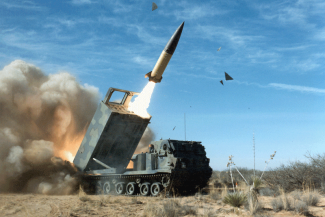Ukraine attacks Crimea. Day 817 of the war


The Ukrainian reserves and subunits sent into Kharkiv oblast from the less threatening areas of the front have slowed the pace of the Russian advance to the level seen along other axes in recent weeks. In order to contain the invaders, the Ukrainians committed at least 14 additional battalions from 12 different brigades, thus increasing their size to around 30 battalions (12,000 troops), which offset the invading forces brought into the fight. Nevertheless, in recent days the Russians have advanced to the outskirts of the junction town of Lyptsi, which lies 16–18 km north of Kharkiv; they have also pushed Ukrainian forces out of the northern part of Vovchansk, over which fierce fighting is continuing. According to official Ukrainian figures, 60% of the town remains under the control of the defenders, but it has been outflanked from the west, making supplies from Kharkiv difficult. In total, as of 10 May, the invaders have captured an area of between 170 and 260 km2, occupying 13 towns during this time (including nine in the first three days of operations and the rest during the following week). The new frontline section is now around 70 km wide, and the incursion is up to 10 km deep. On 19 May, the local authorities in Kharkiv oblast reported that more than 10,000 people had been evacuated from the zone threatened by enemy advances since the Russians opened up the new front.
On 16 May General Christopher Cavoli, commander of US and allied forces in Europe, stated that the Russians did not have the necessary number of troops to make a strategic breakthrough in the Kharkiv oblast, and that their capabilities only allowed for local advances. Cavoli’s words were indirectly confirmed by Pentagon chief Lloyd Austin, who announced that the objective of the Russian operation was to create a buffer zone on the Russian-Ukrainian border, and not to seize Kharkiv city.
It is still unclear whether the introduction of new Ukrainian units into combat will succeed in halting the Russian advance. By the Ukrainians’ own admission, their reserves have been virtually exhausted, and units that are in the process of restoring combat capability and from areas where there is currently less Russian activity are often being directed to fill in gaps in the defence. However, the Ukrainians have succeeded in bringing relative stabilisation to the front and leading the enemy to concentrate their efforts along two axes of attack, Lyptsi and Vovchansk. There are still no signs that the Russians are preparing to develop a larger-scale operation in Kharkiv oblast.
Russian forces intensified their operations in the region of Siversk, from where the Ukrainian command has withdrawn some forces in order to salvage the situation in Kharkiv oblast. There are conflicting reports that the invaders have seized Bilohorivka, to the east of Siversk; this was the last village in this area of Luhansk oblast under Ukrainian control (fighting over it has been ongoing for several months). After several weeks of setbacks, Russian units have taken up positions in the eastern part of Chasiv Yar (in the so-called Kanal microdistrict), while at the same time consolidating their positions south of the town and intensifying the fighting for Kalynivka, which lies to the north. According to some sources, the Russians have also seized the centre of Klishchiivka south-west of Bakhmut, over which fierce battles have been fought intermittently since the summer of 2023. The invaders also made further advances west of Donetsk, seizing most of the village of Netailove (according to some sources, Russian subdivisions have reached the Karlovsky Reservoir) and Heorhiivka neighbouring Marinka, as well as further sections in the eastern and south-western parts of Krasnohorivka. The continued battles for Robotyne south of Orikhiv in Zaporizhzhia oblast have been inconclusive; here, it is now the Russians who are struggling to consolidate themselves in the ruins of this town. The Russians’ renewed assaults on Staromayorske and Urozhaine south of Velyka Novosilka have also ended in failure.
On 15 May, the Ukrainian Centre for National Resistance indicated that the Russians are building new facilities in the occupied territories to store corpses. Most are being built in Luhansk oblast, where bodies of soldiers killed during the offensive in the Kharkiv oblast are being transported. At the same time, the occupying forces have refrained from transporting corpses to the Belgorod oblast of Russia, in order to avoid negative public reactions.

Kharkiv remains the main target of Russian airstrikes, whose importance as the immediate hinterland of the defenders has increased significantly following the start of the operations to the north and north-east of the city. It is still being attacked several times a day, mainly by guided aerial bombs, and to a lesser extent by kamikaze drones and rockets; the local authorities have confirmed the systematic destruction of storage and transport infrastructure facilities. The attacks on Myrhorod airport in the Poltava oblast (15–17 and 20 May), which serves as the main Ukrainian airbase on this section of the frontline, as well as on the energy infrastructure there (18 May), are probably linked to the operations in the Kharkiv area.
The Russians have stepped up their attacks on the Odesa region, from where the defenders are launching most of their strikes into Crimea. The logistical infrastructure there came under rocket fire on 17, 18 and 19 May, and in the following days the invaders attacked the city and its surroundings with kamikaze drones. Damage to infrastructure was also reported from the cities of Dnipro and Mykolaiv (15 May), Vinnytsia oblast (17 May) and Kropyvnytskyi (20 May). In total, from the evening of 14 May until the morning of 21 May, the Russians used 46 rockets, of which the defenders were only able to shoot down between three and six. The Ukrainian Air Force Command claimed a near 100% success rate in repelling Shahed attacks; the Russians used a total of 128 of them in the period of 17–21 May (their use had not been reported in previous days), but only one reached its target. Officially, most of the damage caused by the kamikaze drones was caused by falling debris.

Ukrainian forces launched a series of massive missile attacks into Crimea, resulting in the destruction of Russian military infrastructure. In a series of attacks on Belbek airfield on 15 May, elements of an S-400 air defence system battery were destroyed, followed the next day by combat aircraft, including two MiG-31 fighters carrying Kinzhal hypersonic missiles (an Su-27 was also destroyed and a MiG-29 damaged), as well as a fuel and lubricant depot. On 17 May, a power substation in the Sevastopol area was hit, temporarily cutting off power supplies to the city. In an attack on 19 May, a Russian ship in Sevastopol harbour was destroyed. The Ukrainian Naval Command announced that the minesweeper Kovrovets (a post-Soviet 266-M vessel) had been sunk, while a claim was made on the Russian internet that the vessel destroyed may have been the missile corvette Tsyklon (a Project 22800 Karakurt vessel introduced into service in 2023, capable of carrying Kalibr missiles); the Ukrainian military has distanced itself from this report. So far, however, the claims that the aforementioned vessels were sunk have not been confirmed by visual footage. In each of the attacks, the Ukrainians were said to have used between 10 and 12 ATACMS missiles (an average of two of which were expected to reach their intended targets) as well as kamikaze drones (including surface ones), albeit without much success.
In terms of effectiveness and potential impact on the invaders’ operations, the attacks on Belbek airfield should be considered the most effective since August 2022, when the Ukrainians destroyed an ammunition depot and eight combat aircraft in a strike on Saki airfield. For the first time since the start of the full-scale invasion, the Russians lost some particularly valuable hypersonic missile-carrying interceptor fighters as a result of Ukrainian combat operations (one MiG-31 was destroyed in October 2022 as a result of an accident). Contributing to the observed improvement in the effectiveness of the Ukrainian attacks on Crimea in recent weeks has been the acquisition of a significant number of ATACMS missiles (the Ukrainians have received more than 100 of the 305 km-range version and a larger, unspecified number of missiles with a range of 165 km), allowing them to be used relatively indiscriminately. Although the effectiveness of Russian air defence in Crimea should be considered relatively high (of the order of 85% for ATACMS), it is currently proving insufficient to fully repel the Ukrainian strikes.
The Ukrainians have continued their attacks on Russian fuel infrastructure and on the border regions of the Russian Federation. On 17 May, Ukrainian drones hit a refinery in Tuapse, and on 19 May, a refinery in the town of Slavyansk-na-Kubani (both in Krasnodar krai). Although no major damage was reported, work was halted at both plants. In addition, a power substation in the town of Balashikha near Moscow (15 May) and a transformer & a tank for handling liquid materials in the port of Novorossiysk (17 May) were reportedly damaged. Reports of an attack on a fuel depot in Vyborg in Leningrad oblast (19 May) proved untrue, and a strike on a similar facility in the Rostov oblast on 15 May failed. On 17 May, the Ukrainians used a record number of kamikaze drones; according to Russian accounts, up to 102 of them were shot down (including 51 over Crimea and 44 over Krasnodar krai). In contrast, two days later, the largest Ukrainian attack to date took place over Krasnodar krai, using 57 drones.

On 15 May, the Security Service of Ukraine (SBU) detained three people involved in an psychological propaganda operation carried out on social networks to discredit the Ukrainian army and encourage Ukrainians to lay down their arms (including the creation of animated videos). According to the SBU, those arrested were acting on behalf of the political movement Another Ukraine, which was established in Russia and led by the FSB-controlled pro-Russian politician Viktor Medvedchuk and the journalist Denys Zharkikh.

On 17 May, President Volodymyr Zelensky signed a law allowing the voluntary mobilisation of certain categories of prisoners. The new legislation allows a convicted prisoner to be paroled for contractual military service. Any decision to do so will be taken by a court after taking a positive decision by a medical commission into account. Those convicted of intentional murder or rape, as well as officials convicted of corruption, are among categories of prisoner who will not be able to join the army.
On 18 May, new legislation regulating mobilisation issues and designed to motivate Ukrainian men aged between 25 and 60 to register with military commissions (within 60 days) came into force. The State Border Service of Ukraine will check that those crossing the border hold a certificate confirming their registration and deferment from service. Men deemed unfit for military service for health reasons, or who are supporting three or more children under the age of 18 or raising a child alone will be able to leave Ukraine on the basis of a certificate from a military commission. Also from 18 May, the foreign ministry reinstated the provision of consular services by diplomatic missions to men of mobilisation age, which had been suspended since 23 April. The condition for receiving these services is the presentation of a document of military registration, in paper or electronic form.
On 20 May, a spokesperson for the Ukrainian defence ministry indicated that more than 400,000 men of conscription age had updated their registration data using the Reserve+ mobile application, which has been available since 18 May. Its operators recorded a total of 620,000 downloads. The app is also active outside Ukraine, and the service centre operates around the clock.
On 20 May, Ukrainian police reported that 94,500 men were wanted for evading military service, on the basis of data received from the military commissions. Most of these are from Dnipropetrovsk oblast: by 20 May more than 20,000 men had been detained and brought before the commissions. This data relates to only 10 oblasts; no information was provided from 10 others (including Kyiv, Odesa and Lviv).

The main part of the eighteenth military support package from Denmark, worth $815 million, will go towards equipping Ukraine’s air defence (it will account for $349 million of the funding), Danish defence minister Troels Lund Poulsen announced on 16 May. The remaining funds will be allocated to artillery (probably to keep purchasing French CAESAR howitzers, as well as supplies of spare parts and ammunition), to investments in the Ukrainian arms industry, and to the delivery of F-16 fighters which is expected in the summer. According to the head of Germany’s Rheinmetall, Armin Papperger, the 40 Marder 1A3 infantry fighting vehicles previously promised by Berlin are expected to arrive in Ukraine between May and September this year. He also announced a plan to set up an air defence systems manufacturing company in the country. This is the fourth announcement that Rheinmetall will build plants in Ukraine. Over the past several months, the corporation has announced it will set up companies to produce tanks & ammunition and repair combat vehicles. So far, however, there have been no reports that any action to implement these announcements has been taken. Most probably they are just part of Rheinmetall’s self-promotion. On 17 May Lithuania joined the so-called air defence coalition, as part of which it plans to transfer six Amber-1800 radiolocation stations (manufactured by the Lithuanian company LiTak-Tak) to Ukraine, as announced by German defence minister Boris Pistorius.
The Ramstein-format meeting of the Contact Group of States Supporting Ukraine militarily (the 22nd in succession), held online on 20 May, did not result in any new announcements of deliveries. The heads of the defence ministries of Spain, Margarita Robles, and the Netherlands, Kajsa Ollongren, confirmed their earlier announcements of the delivery of a batch of Leopard 2A4 tanks (at the end of June) and YPR-765 infantry fighting vehicles (‘in the near future’) respectively. Chairing the meeting, Pentagon head Lloyd Austin stressed the importance of efforts to strengthen Ukraine’s air defence, and recalled that the value of Western military aid as of February 2022 exceeded $95 billion. The German defence ministry announced that new countries would be joining the so-called air defence coalition.





